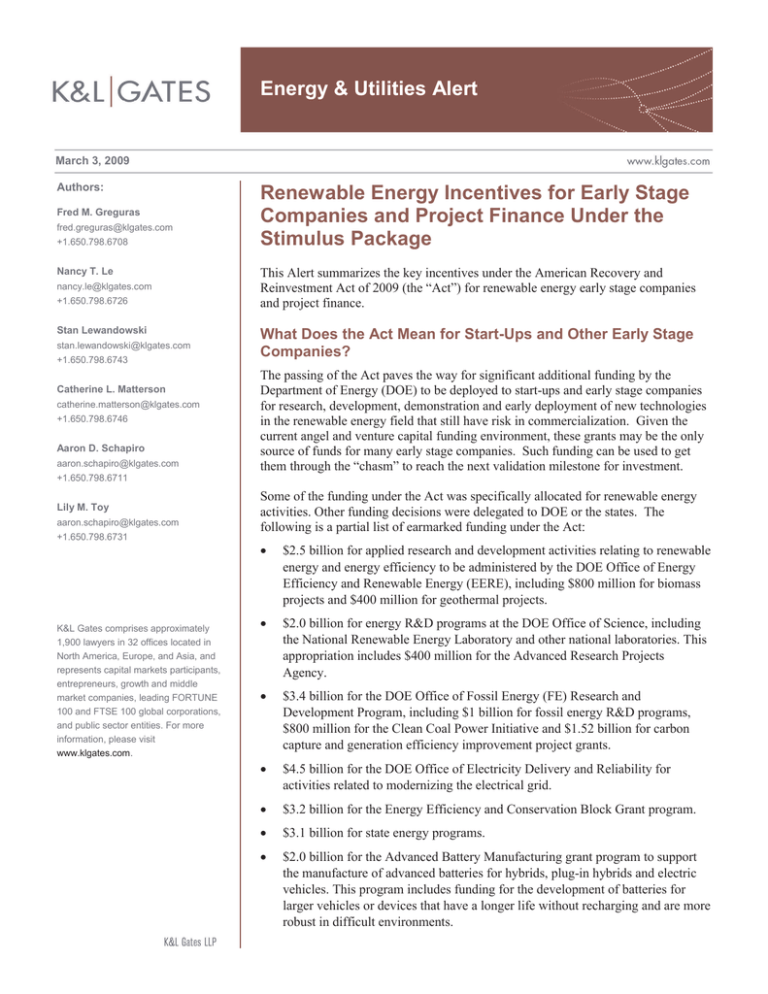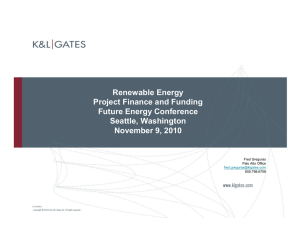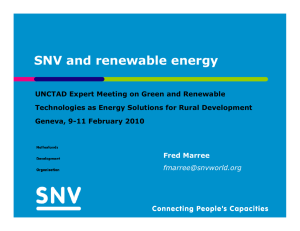
Energy & Utilities Alert
March 3, 2009
Authors:
Fred M. Greguras
fred.greguras@klgates.com
+1.650.798.6708
Nancy T. Le
nancy.le@klgates.com
+1.650.798.6726
Stan Lewandowski
stan.lewandowski@klgates.com
+1.650.798.6743
Catherine L. Matterson
catherine.matterson@klgates.com
+1.650.798.6746
Aaron D. Schapiro
aaron.schapiro@klgates.com
Renewable Energy Incentives for Early Stage
Companies and Project Finance Under the
Stimulus Package
This Alert summarizes the key incentives under the American Recovery and
Reinvestment Act of 2009 (the “Act”) for renewable energy early stage companies
and project finance.
What Does the Act Mean for Start-Ups and Other Early Stage
Companies?
The passing of the Act paves the way for significant additional funding by the
Department of Energy (DOE) to be deployed to start-ups and early stage companies
for research, development, demonstration and early deployment of new technologies
in the renewable energy field that still have risk in commercialization. Given the
current angel and venture capital funding environment, these grants may be the only
source of funds for many early stage companies. Such funding can be used to get
them through the “chasm” to reach the next validation milestone for investment.
+1.650.798.6711
Lily M. Toy
aaron.schapiro@klgates.com
+1.650.798.6731
K&L Gates comprises approximately
1,900 lawyers in 32 offices located in
North America, Europe, and Asia, and
represents capital markets participants,
entrepreneurs, growth and middle
market companies, leading FORTUNE
100 and FTSE 100 global corporations,
and public sector entities. For more
information, please visit
www.klgates.com.
Some of the funding under the Act was specifically allocated for renewable energy
activities. Other funding decisions were delegated to DOE or the states. The
following is a partial list of earmarked funding under the Act:
·
$2.5 billion for applied research and development activities relating to renewable
energy and energy efficiency to be administered by the DOE Office of Energy
Efficiency and Renewable Energy (EERE), including $800 million for biomass
projects and $400 million for geothermal projects.
·
$2.0 billion for energy R&D programs at the DOE Office of Science, including
the National Renewable Energy Laboratory and other national laboratories. This
appropriation includes $400 million for the Advanced Research Projects
Agency.
·
$3.4 billion for the DOE Office of Fossil Energy (FE) Research and
Development Program, including $1 billion for fossil energy R&D programs,
$800 million for the Clean Coal Power Initiative and $1.52 billion for carbon
capture and generation efficiency improvement project grants.
·
$4.5 billion for the DOE Office of Electricity Delivery and Reliability for
activities related to modernizing the electrical grid.
·
$3.2 billion for the Energy Efficiency and Conservation Block Grant program.
·
$3.1 billion for state energy programs.
·
$2.0 billion for the Advanced Battery Manufacturing grant program to support
the manufacture of advanced batteries for hybrids, plug-in hybrids and electric
vehicles. This program includes funding for the development of batteries for
larger vehicles or devices that have a longer life without recharging and are more
robust in difficult environments.
Energy & Utilities Alert
The key issue is whether the grant application and
decision-making process will be simplified and
shortened so as to make such funds available
quickly. We recommend that grant applicants try to
convince the funding source that the results of the
project could be “game changing” in order to have a
competitive advantage over other applicants.
What Does the Act Mean for Project
Finance?
In an effort to attract both debt and equity investors
back into the marketplace, the Act provides various
incentives for commercial (such as power purchase
agreement financings) and private utility project
finance. These incentives are discussed below.
Department of Treasury Grants in Lieu of
Renewable Energy Tax Credits.
The current situation in the capital markets has
significantly undermined the effectiveness of the
production tax credits (PTCs) for electricity
produced by certain energy facilities and the
investment tax credits (ITCs) for certain energy
generating property. The Act attempts to remedy the
status quo by providing a set of more beneficial tax
provisions for the remaining investors and creating a
new program administered by the Department of
Treasury that provides grants equal to 30% (or 10%
for combined heat and power or qualified
microturbines) of the cost of “qualified facilities” or
energy property in lieu of PTCs and ITCs. Qualified
facilities eligible for the 30% grant include wind,
closed- and open-loop biomass, hydropower,
municipal solid waste, solar, landfill gas,
geothermal, qualified small wind, and qualified fuel
cell. In order to qualify for the grant, the facility
must be placed in service during 2009 or 2010, or
the facility’s construction must commence in 2009
or 2010 and must be completed before the “credit
termination date” (which ranges from January 1,
2013 to January 1, 2014 depending on the type of
the facility). Treasury is required to make payment
of the grant within sixty days of the facility’s being
placed in service or, if later, within sixty days of
Treasury’s receipt of an application for such grant.
The result of this incentive is to make the ITC
refundable for qualifying renewable energy
facilities. This incentive is intended to help reduce
financing risks by providing the full value of the
incentives for renewable energy projects even
during the financial crisis. It is anticipated that the
grants will provide similar near-term benefits as the
ITCs and help reinvigorate the hard hit
manufacturing and construction sectors.
Bonus Depreciation.
The Act extends first-year bonus depreciation for
capital expenditures related to property placed in
service in the United States in 2009, i.e., an owner
of qualifying property placed in service in 2009 may
deduct 50% of the cost of such property (or a
reduced percentage if an owner also elects the ITC).
The remaining 50% would be depreciated over the
regular tax depreciation schedule for subsequent
years.
Full Amount of Investment Tax Credit
Available Even if Subsidies Used.
The Act also permits the use of the full amount of
the ITC even if projects receive subsidized
financing (such as below-market-interest loans, state
grants, etc.) and allows the full 30% credit for small
wind generators. In addition, equipment used to
manufacture renewable energy components and
systems is now eligible for the ITC and accelerated
depreciation.
Investment Tax Credit in Lieu of Production
Tax Credit.
Renewable energy facilities that qualify for the PTC
may apply the 30% ITC instead for facilities placed
in service in 2009 or 2010. This will enable wind
power generation project developers to temporarily
claim the up-front ITC instead of the PTC, which
must be used over ten years, and thereby help such
projects attract financing during the credit crunch.
The Act also provides an extension of the energy
PTC through December 31, 2012.
DOE Temporary Loan Guarantee Program.
A new DOE temporary loan guarantee program was
established by the new Section 1705 of the Energy
Policy Act of 2005 for renewable energy systems
(which includes biofuel projects and renewable
energy manufacturing facilities) and electric power
transmission projects. The underlying purpose was
to spur the rapid deployment of renewable energy
projects. The DOE is looking for projects that meet
reliability needs and have a positive effect on a
state’s or region’s environment and energy needs.
March 3, 2009
2
Energy & Utilities Alert
Congress appropriated $6 billion to pay the credit
subsidy costs, which should support $60 billion
worth of loan guarantees.
Eligible projects must generate electricity or thermal
energy or manufacture related components and
commence construction by September 30, 2011. The
new program is available for projects that deploy
proven technologies as well as leading-edge biofuel
projects that use technologies performing at pilot or
demonstration scale. Its value as an incentive will
depend on the speed and practicality of its
implementation by DOE.
This provision eliminates the significant burdens
that had been placed on applicants under the preexisting DOE loan guarantee programs. No loan
guarantees have been issued under the pre-existing
DOE loan guarantee programs as described in Title
XVII of the Energy Policy Act of 2005 and at 10
C.F.R. part 609, Loan Guarantees for Projects that
Employ Innovative Technologies. Such programs
may be used only for projects that employ new or
significantly improved technologies as compared to
technologies in service at the time the guarantee is
issued and there must be a reasonable assurance of
repayment of the loan. In addition, the applicant
must pay a credit subsidy fee to create a bad debt
reserve to cover the credit risk cost since Congress
did not appropriate any funds to support the
program. The pre-existing programs are not
available for proven technologies and thus do not
support projects that involve relatively low risk and
have a reasonable assurance of repayment. The
existing programs are too slow, too expensive for
applicants and too restrictive.
DOE Secretary Steven Chu has promised to reform
the DOE and speed up the loan guarantee process.
He has committed to streamline the review process
and give less scrutiny to each loan guarantee. He
expects to start issuing loan guarantees within five
months from the date the Act was enacted.
Secretary Chu also wants the DOE to spend more
than half the appropriation money in the first year.
To have a real impact on financing projects and
creating jobs, the new federal loan guarantee
program as implemented should have a rolling
application process, a streamlined process for
making decisions on applications, and be available
for packages of identified, commercial projects in
the aggregate amount of at least $25 million, rather
than only for single utility scale projects.
K&L Gates comprises multiple affiliated partnerships: a limited liability partnership with the full name K&L Gates LLP qualified in Delaware and
maintaining offices throughout the U.S., in Berlin and Frankfurt, Germany, in Beijing (K&L Gates LLP Beijing Representative Office), in Singapore
(K&L Gates LLP Singapore Representative Office), and in Shanghai (K&L Gates LLP Shanghai Representative Office); a limited liability partnership
(also named K&L Gates LLP) incorporated in England and maintaining our London and Paris offices; a Taiwan general partnership (K&L Gates)
which practices from our Taipei office; and a Hong Kong general partnership (K&L Gates, Solicitors) which practices from our Hong Kong office.
K&L Gates maintains appropriate registrations in the jurisdictions in which its offices are located. A list of the partners in each entity is available for
inspection at any K&L Gates office.
This publication is for informational purposes and does not contain or convey legal advice. The information herein should not be used or relied upon
in regard to any particular facts or circumstances without first consulting a lawyer.
©2009 K&L Gates LLP. All Rights Reserved.
March 3, 2009
3









